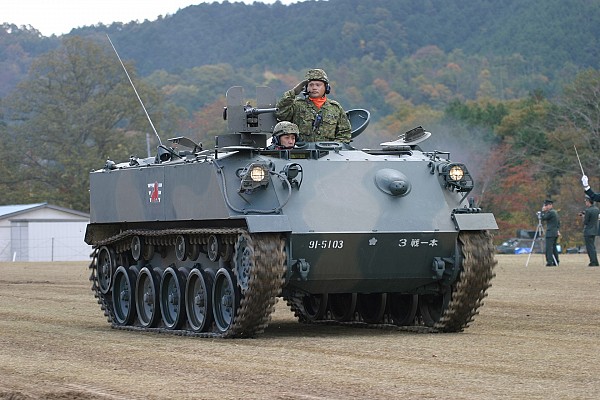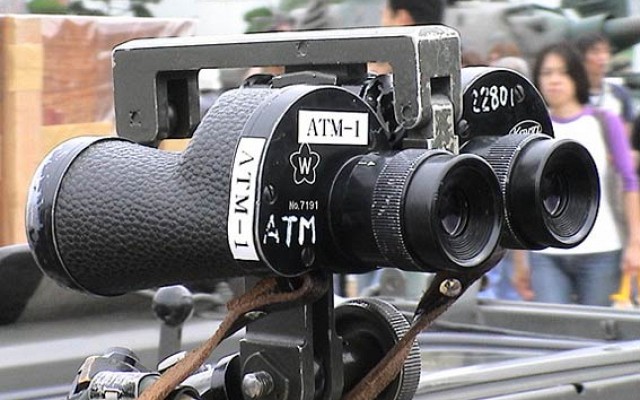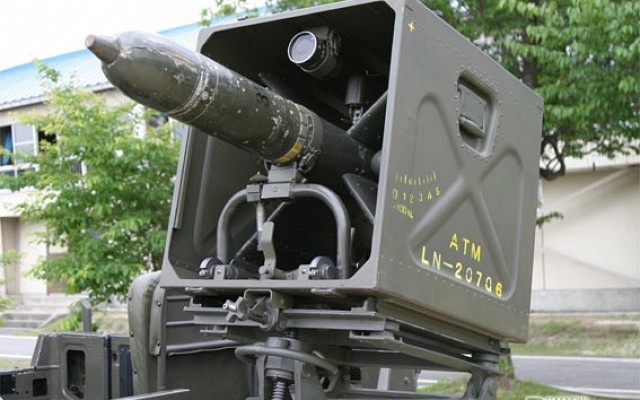Type 64 MAT
KAM-3
Overview

Type 64 MAT
Type 64 MAT anti-tank guided missile seen on its launch rail.
Source: www.rightwing.sakura.ne.jp -
© Copyright lies with original owner
KAM-3D
64MAT
64式対戦車誘導弾
ATM-1
Description
Introduction
The Type 64 MAT is an early Cold War era anti-tank guided missile of Japanese origin. It is the first operational Japanese anti-tank missile and was developed for domestic service only. The role of the Type 64 MAT is to provide infantry and other light formations with credible anti-tank capabilities beyond the range of recoilless rifles. Alternative designations for this missile system include KAM-3D and ATM-1.
Design
The Type 64 MAT is a wire guided missile with a HEAT warhead. It is easily recognizable by its four large square wings mounted at the rear of the missile body. The solid propellant rocket motor has two stages. The first stage burns within a second and accelerates the missile to flight speed. The second stage acts as a sustainer motor. The missile is launched at an upward angle from a portable launch rail. The MCLOS control station is tripod mounted and features a binocular and joystick for missile control.
Fire control
The Type 64 MAT uses manual control to line of sight (MCLOS) guidance. This means that the operator tracks both the missile and the target and uses a small joystick to manually guide the missile onto the target. This requires extensive training to become proficient. In a test setting 19 out of 20 experienced operators could hit their target. The slow flight speed of the missile makes it easier to steer on target, but is otherwise a serious drawback of the system.
Firepower
The Type 64 MAT has a single HEAT warhead penetrating about 350 mm to 400 mm RHA. This was adequate upon introduction, but with the introduction of explosive reactive armor the Type 64 MAT became practically obsolete. The Type 64 MAT has a maximum range of 1.8 km. Some sources list a shorter range of 1.6 km. Since the missiles are launched at a 15° upward angle there is a 350 m dead zone upon launch. Time of flight to maximum range is a serious drawback, being about 25 seconds. When detected this allows the enemy to launch smoke and/or engage the firing position.
Variants
Mobility
The Type 64 MAT is a man portable system consisting of the missile, its launch rail and separate control station. On vehicles the same control station is used. On vehicle mounts the missiles are placed in open metal boxes to protect the missiles from foliage.
Users
The Type 64 MAT was developed for use by the Japan Ground Self-Defense Force. In line with Japanese legislation it was never offered for export. The production run consisted of at least 220 control stations and perhaps more. The Type 64 MAT remain in service for a long time, even when supplemented by newer and more capable systems. Reportedly it was removed from service in 1997.
Details
Launch platforms

Manpack system
The Type 64 MAT was developed as a manpack system. This consists of the missile and its launch rail. The control station is a separate tripod mounted unit that can be placed some distance away from the launch rail and is connected by wire.

Type 73 jeep
For improved mobility the Type 64 MAT was also employed on the Type 73 4x4 utility vehicle. With the windscreen folded the silhouette is quite minimal. Two missiles are ready for launch in square launch containers. The control station is mounted at the passenger seat.

Type 60 ATM tank destroyer
The Type 60 ATM combines the Type 64 missile system with the SU-60 tracked armored personnel carrier. Two missile launch boxes are located on a mount over the rear of the vehicle. When on the move the launch boxes are manually swung inwards and face to the rear. A single missile can be fired and controlled from the vehicle at a time.
Media
Related articles

SU 60
The SU 60 tracked armored personnel carrier was one of the vehicles armed with the Type 64 MAT.













